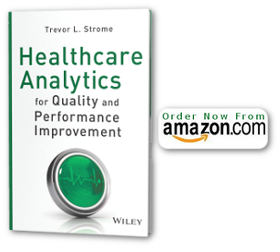Effective communication is key for any quality improvement initiative
Information that is “locked up” in obscure reports and complex tables or presented in ways that does not engage front-line staff is essentially a wasted resource. For healthcare improvement goals to succeed, it is important to share the process and quality improvement goals of a healthcare organization (HCO), and progress towards achieving those goals.
There are many ways in which Business Intelligence (BI) and analytics tools can help to promote improvement goals and objectives of a quality improvement project. Some ways in which analytics and communications go hand-in-hand include:
- highlighting new processes and identifying performance targets,
- showcasing and acknowledging progress made towards achieving the improvement goals, and
- demonstrating that improvement efforts are being noticed by staff and management.
The bottom line is that taking the time to engage front-line staff in meaningful ways via analytics can help encourage buy-in to and more active participation in improvement initiatives when they can monitor the progress that is being made.
Start slow, then grow!
If even basic process and quality improvement data is not available to front-line staff, it is likely that engagement in improvement activities will suffer, along with the improvement efforts themselves.
Engaging staff does not mean drowning them with data and contributing to information overload! Providing all front-line staff with access to the HCO’s analytics portal and having them sift through dozens of reports and dashboards (if not more) is not likely to enable engagement! Many HCOs with successful healthcare transformation initiatives habitually post progress results in locations highly visible to staff. These “quality boards” typically will contain print-outs of key performance indicators (and other statistics) so that staff can see, at a glance, what the performance targets are, and what progress is being made towards those targets.
Although seemingly “low-tech”, quality boards are an effective method of sharing information and communicating results. As the paper-based boards gain traction, many healthcare organizations will migrate to electronic dashboards in areas visible to staff. These electronic dashboards have the added benefit of displaying near-real-time performance indicators as well as past trends.
Making analytics results available to staff in accessible locations and “user-friendly” formats will help engage staff in healthcare improvement initiatives, and will increase the value that analytics provides your organization.
Note: The above article is adapted from a section of our special report, Overcome Common Barriers to Effective Implementation of Healthcare Analytics, available for download in the resources section.

{ 0 comments… add one now }